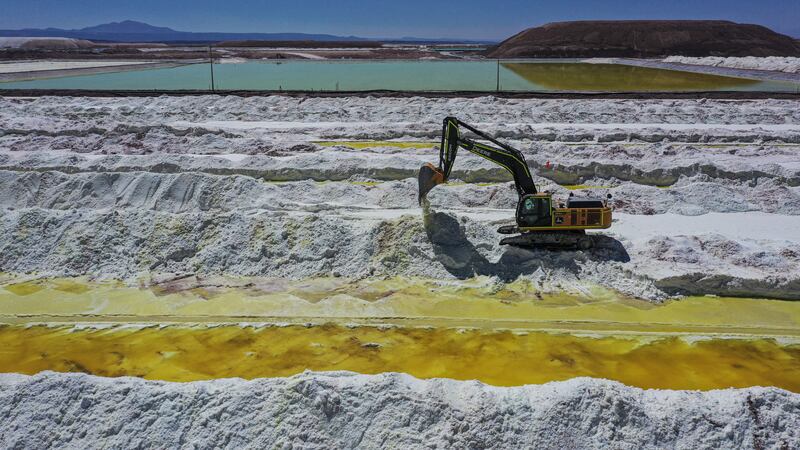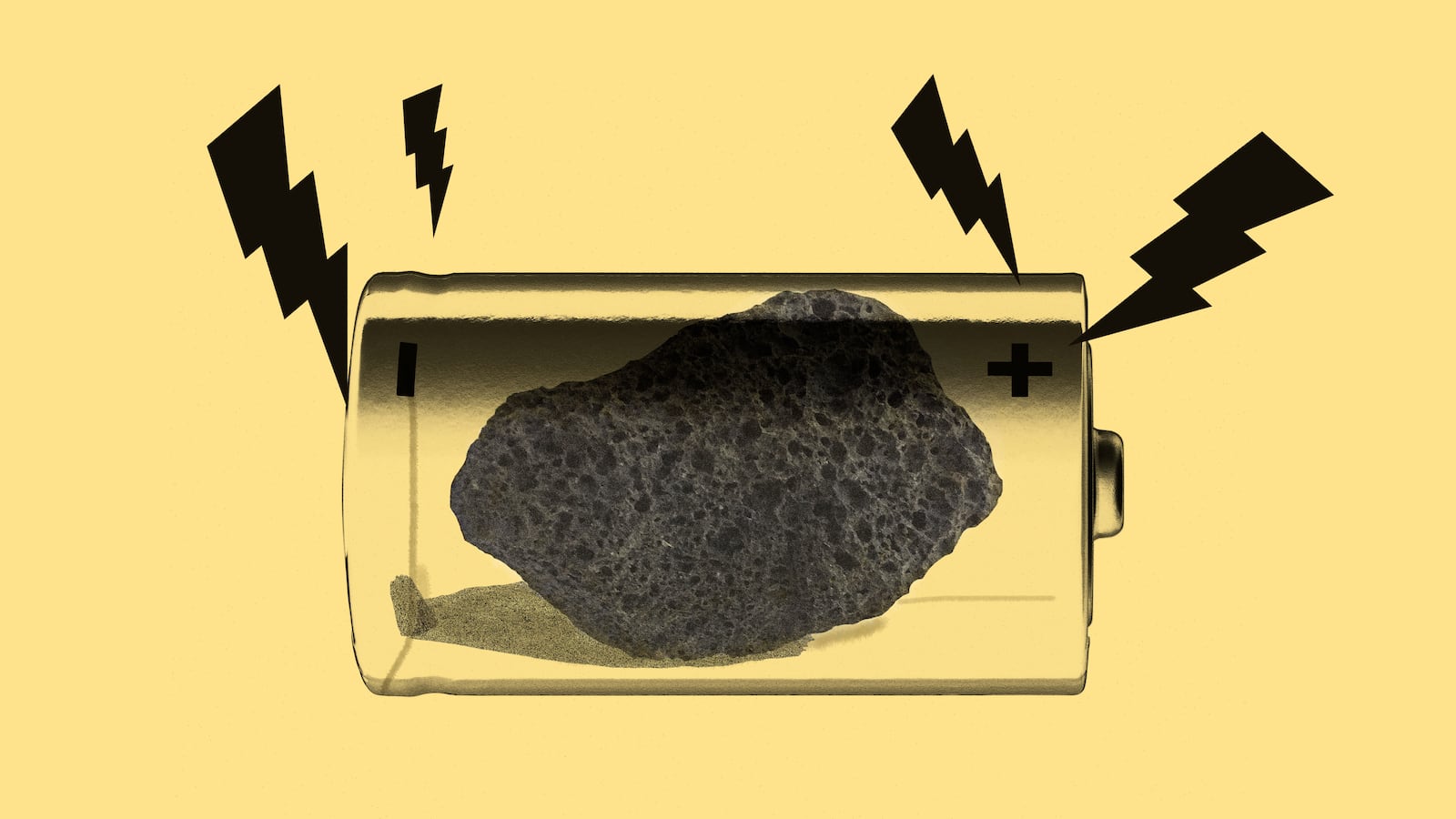Renewable energy might be finally taking off. The price of solar panels and wind turbines has fallen, and production of green technology has ramped up. The main problem is that renewable energy production is not uniform: When the wind stops blowing or the sun stops shining, there’s no power. At other times, there’s more energy than the grid can handle, which can lead to it becoming unstable.
This is where battery technology comes in. At the moment many grid-scale approaches use lithium-ion batteries, which suffer from performance, cost, and environmental issues. Another problem is that certain sectors such as industrial production—which is behind nearly 25 percent of all greenhouse gas emissions—need to produce extremely high temperatures that existing batteries can’t generate. This makes electrification, and the use of renewables, difficult for these sectors. Luckily, one new material might unlock the future of the battery and move towards solving these problems: rocks.
OK, maybe it’s not that new.
A growing number of companies have recently produced battery systems using common rocks that can connect directly to wind and solar, or electricity sourced through the grid. When the energy is captured, the system turns it into heat, which is then stored in the rocks. Later, when users need power, the heat is then converted into superheated steam or electricity that can be used for energy. For example, Brenmiller Energy uses crushed volcanic rock; Antora Energy makes use of graphite; and Rondo uses bricks.

Aerial view of brine ponds and processing areas of the lithium mine of the Chilean company SQM in the Atacama Desert, Calama, Chile. Lithium batteries suffer from performance, cost, and environmental issues. Luckily, one new material might unlock the future of the battery and move towards solving these problems: rocks.
Martin Bernetti / Getty ImagesBattery startup Energy Vault even lifts enormous concrete blocks using hydropower to store energy. When they need power, they simply drop the blocks, which then pull what is essentially a large rope start cord, allowing the system to harness the energy from the fall. These approaches are particularly useful for reducing industrial emissions, as factories can use the heat directly from the batteries, which then connects to renewable production when they otherwise wouldn’t be able to.
Don’t be fooled by the simplicity: this type of energy storage is not as easy as choosing any rock off the ground. “When selecting the material, a few things come into consideration,” Doron Brenmiller, chief business officer at Brenmiller Energy, told The Daily Beast. “First, heat capacity. Then you have to think about other parameters like cost, the availability of the material, and what happens to the material over time.”
He added, “We use volcanic rocks because they have particularly good heat capacity, and they can be sourced quite easily.”
Ry Storey-Fisher, communications and policy manager from Antora agrees. “In our case, we use blocks of solid carbon,” he told The Daily Beast. “This is an earth-abundant material that’s produced in millions of tons a year… [These blocks] stay stable to extremely high temperatures, and we basically heat those up to thousands of degrees Celsius in an insulated container, like a shipping container-sized module.”
They’re not the only ones making use of common materials to assist with the renewable energy transition. Researchers at MIT recently published a paper on a superconductor material produced using a mixture of cement and carbon black. Carbon black is a powdered form of almost-pure carbon, usually used as a black pigment or a material for strengthening tyres. This type of battery does not release heat, but rather electricity.
It works by mixing the carbon black with water, which then clumps like flour. This combination is then mixed into cement, which draws the water away from the carbon black, leaving numerous branching, wire-like structures throughout the material. This material can then receive and release energy through these carbon black “wires”. Franz-Josef Ulm, a structural engineer at MIT and co-author of the study, told The Daily Beast that the idea came to them because “the cement industry is responsible for about 8 percent of the carbon dioxide in the world. So we thought, ‘Let’s add a new function to it.’”
Admir Masic, another structural engineer at MIT and co-author of the study, told The Daily Beast that it is “important for us to realise how difficult and challenging the energy transition is from non-renewable to renewable.”
“We already know that the production of batteries all around the world creates incredible stresses on societies, communities, and countries,” he added. When new battery types are being developed, there is hope for alternative technologies that are not so damaging.

An illustration of a Rondo heat battery. The system works by storing renewable energy as heat within bricks. When the power is needed, the heat is converted into superheated steam that can be used to harness energy.
RondoMasic also highlights the potential for developing markets to use their material to leapfrog. Materials like cement or bricks “are familiar and available to everyone everywhere in the world. There are no bottlenecks.” As a result, he says that “it will allow us to penetrate markets that are currently completely out of the game.”
“You can imagine the Global South having access to technology that really would facilitate the renewable energy transition,” he said.
The development of these kinds of technologies bodes well for the reduction of industrial emissions, and thermal energy storage at least is already popular. Adam Frankel, vice president of communications and public policy at Antora, told The Daily Beast that for their thermal energy storage technology, “the next phase is manufacturing these at scale … to meet the significant commercial demand that we’re seeing for these products.”
Think Smaller
While Brenmiller Energy also successfully focuses on industrial heat, smaller projects can also make use of this technology. For example, Brenmiller is working with a brewery and a hospital to help them move away from fossil fuels. Both the brewery and the hospital currently use fossil-fuel driven boilers, but with the new battery system based on volcanic rock, both are able to use renewables instead to produce steam and heat. In both cases, switching to thermal energy storage reduces emissions.
Ulm believes the path towards commercialization of their superconductor material will be by sector, and says that it may be able to be used for applications such as “energy autarchic homes, wind energy, maybe tidal waves, and self-charging roads.”
While each additional step in research and development helps the field as a whole to improve, there is still more work to be done. “Every application has to be developed separately,” he said. “Right now when you buy a battery off the shelf, this is a result of 30 years of research.”
Nonetheless, there is a huge amount of hope. Frankel says “it is inspiring” to do this kind of work, with so many people working together to improve these technologies and scale them up. The goal of reducing emissions seems to be a shared one that even goes beyond corporate competition.
“I don’t compare a truck to a car, or a motorcycle or a boat,” Brenmiller said. “To meet 100 percent of your transportation needs, you need a lot of vehicles. It’s the same for energy storage and for renewable energy.”
Decarbonization is a process that needs to be carried out across the board: thermal energy batteries can provide some of the solution, lithium-ion batteries provide another part, and heat pumps and hydrogen can also play a role.
Ulm sees a bright future for technologies like this. “We hope that this type of research will start making the energy transition part of our culture,” he said. “We want to provide energy storage for everyone, everywhere.”







